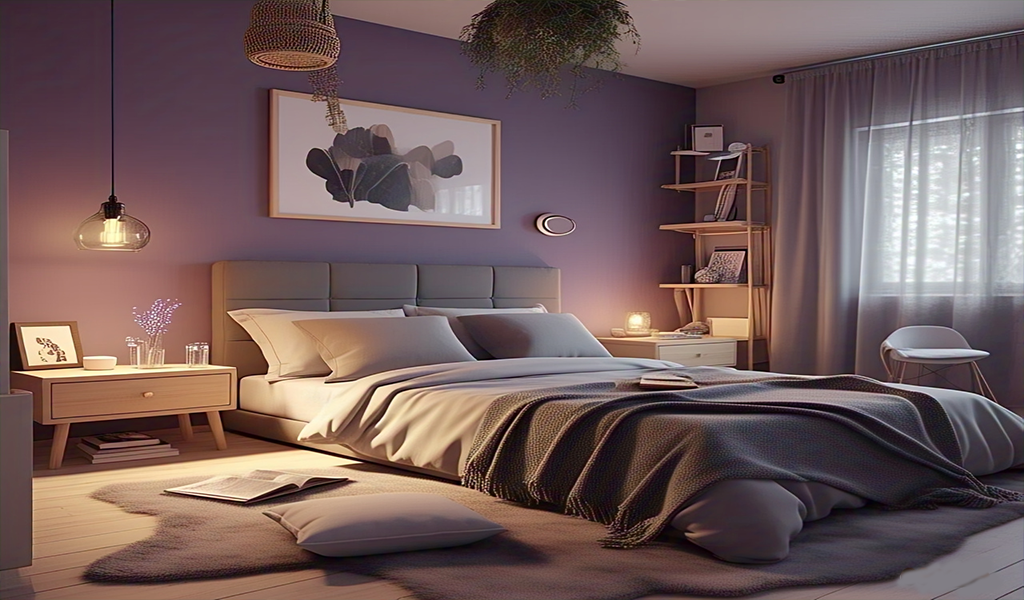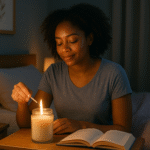A well-optimized sleep environment can mean the difference between tossing and turning and waking up refreshed. Studies show that factors like light, temperature, and noise significantly impact sleep quality.
If you struggle with falling asleep, staying asleep, or feeling groggy in the morning, tweaking your bedroom setup could be the game-changer you need.
1. Control Light Exposure
Block Out Artificial Light
-
- Use blackout curtains or a sleep mask to eliminate streetlights and early morning sun.
-
- Even small LED lights (from chargers, TVs, or alarms) can disrupt melatonin production.
Limit Blue Light Before Bed
-
- Avoid screens (phones, laptops, TVs) 1–2 hours before bedtime.
-
- If necessary, use blue light filters (Night Shift, f.lux) or amber-tinted glasses.
Use Warm, Dim Lighting in the Evening
-
- Swap bright overhead lights for soft, warm bulbs (under 3000K).
-
- Try salt lamps or dimmable bedside lamps to signal your brain that it’s time to wind down.
2. Set the Perfect Temperature
Keep It Cool (60–67°F / 15–19°C)
-
- Your body temperature drops to initiate sleep—a cooler room helps this process.
-
- Too hot? Try moisture-wicking pajamas or a chill pillow (gel-infused or cooling memory foam).
Improve Airflow & Ventilation
-
- A fan, open window, or air purifier can prevent stuffiness and improve oxygen flow.
-
- Bonus: White noise from a fan can also mask disruptive sounds.
3. Reduce Noise Disturbances
Block Out Unwanted Sounds
-
- Use earplugs (silicone ones are comfier for side sleepers).
-
- Try a white noise machine (or apps like Rain Rain, Noisli) to drown out traffic, snoring, or noisy neighbors.
Soothing Sounds for Relaxation
-
- Nature sounds (rain, ocean waves) or binaural beats (theta waves for deep sleep) can help.
4. Choose the Right Mattress & Bedding
Pick a Supportive Mattress
-
- Side sleepers: Softer mattresses (memory foam) for pressure relief.
-
- Back/stomach sleepers: Firmer support to keep spine aligned.
Upgrade Your Pillows
-
- Stomach sleepers: Soft, flat pillows.
-
- Back sleepers: Medium support.
-
- Side sleepers: Firm, thicker pillows to align neck and spine.
Breathable, Comfortable Bedding
-
- Natural fabrics (cotton, linen, bamboo) regulate temperature better than synthetics.
-
- Weighted blankets (10% of body weight) can reduce anxiety for deeper sleep.
5. Minimize Clutter & Stress Triggers
Keep Your Bedroom Clean & Calm
-
- A cluttered room = a cluttered mind.
-
- Avoid work materials, electronics, or anything stressful in sight.
Use Calming Scents
-
- Lavender, chamomile, or sandalwood (via diffusers or linen sprays) promote relaxation.
-
- Avoid strong artificial fragrances—they can be irritating.
6. Optimize Humidity Levels (40–60%)
-
- Too dry? A humidifier prevents dry sinuses and sore throats.
-
- Too damp? A dehumidifier reduces mold and allergens.
7. Reserve Your Bed for Sleep (Only!)
-
- Train your brain to associate bed with sleep and intimacy only—no work, TV, or scrolling.
-
- If you can’t sleep after 20 minutes, get up and do something relaxing (reading, stretching) until drowsy.
Final Checklist for the Perfect Sleep Environment





When to See a Sleep Specialist
If you’ve optimized your sleep environment but still struggle with:
-
- Chronic insomnia
-
- Loud snoring/gasping (sign of sleep apnea)
-
- Restless legs or frequent waking
…consult a sleep doctor for further evaluation.




